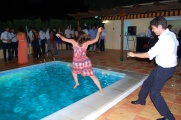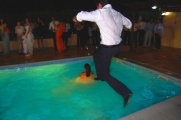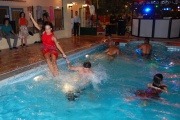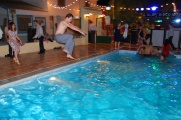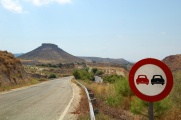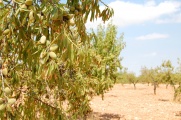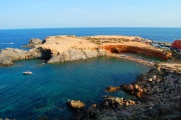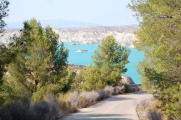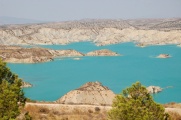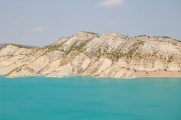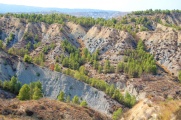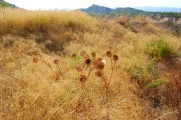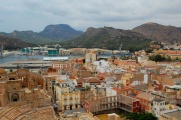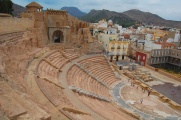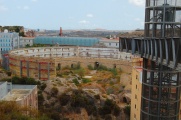Wedding of Leo and Alejandro
![]() The recollections below are mine.
The recollections below are mine.
Our friend Alejandro got married in August (2013) with Leonor, in their native Murcia. We have been honored to be invited and, from Munich, flew over to this less known part of Spain, where we have also explored a few spots of interest. These will forever remain in our mind associated to the young couple (ironically, now starting a new page of their life also in Munich).
While we knew there is a village named Tudela in northen Spain, we found out during this trip that this is a name very much imprinted in Murcia too, with a Calle Tudela in Mula and a Joyeria Tudela on the main square (Plaza del Arco) of Caravaca de la Cruz.
Memories of this trip and of the wedding itself are kept for future nostalgia here below.
Murcia
Murcia is originally the name, not of the province itself, but of its main city; some laziness in naming things that I do not like very much. It is the largest city in south-eastern Spain (seventh overall). It was founded by the emir of Cordoba Abd ar-Rahman II in 825 with the name Mursiyah (مرسية). Therefore it is lucky it did not become Morcilla. The main sight is the cathedral (Santa María), built on the site of the mosque by James I of Aragon after he conquered the city from the Muslims. It is an impressive multi-styled church with the tallest campanile in Spain and ranks in my opinion as one of the main sights you must get from the Iberian peninsula.
-
Murcia's cathedral.
-
Its impressive belltower, the tallest in Spain.
-
View with the Episcopal palace on the Plaza de Belluga.
Mula
Mula is a small town with some tradition of drumming processions (tamboradas) during the holy week, where the Spanish folklore finds one of its neatest way of expression. Its coat of arm features a mule. It is crowned by a castle (in ruins) sitting on a rock [2], from which one can get a nice view of the Murcian roofs and distant relief. We met a British family at various points of the ascent, and had to socialize at some point from the repeated clues we were giving each others as to which path is the less likely to result in a nasty fall (the lady had thongs). The square of the village in the old city center has a nice atmosphere of the quiet life going after its business, with old people on the benches looking at young ones playing. A very inclined street supporting cars and lorries pushes with all its weight on a tiny shop, the Libreria de la Plaza, cast below it with the hairdresser's shop. As we looked at all that, drinking the 1.5L bottle of cold mineral water we bought for fifty cents, a dog hopped on the bench and got himself comfortable by the flank of Elena.
-
Mula's historical center crowned by its castle.
-
With mountains of character in its background.
-
En route towards the castle.
-
View over the Murcian roofs.
-
Closer to the top, the way becomes a bit more harduous.
-
A sight that had impressed Al Idrisi.
Caravaca de la Cruz
Caravaca de la Cruz became a must-go destination ever since we knew Alejandro, who insisted it was extremely famous as one of the five holy cities of Catholicism, along with Rome, Jerusalem, Santiago de Compostela and another, obscure city (Camaleño). In fact it acquired this status only in 1998, and in the sense of being granted a papal and perpetual right to celebrate a jubilee (there are otherwise a lot of holy cities). It might therefore become that famous, in the near future. It is otherwise indeed renowned for the erudite, for its cross, a variation of the Patriarchal cross, associated to a legend according to which a piece of the True Cross was brought to Caravaca by angels so that a priest could perform the mass for a curious Muslim ruler. The relics is now contained in a reliquary shaped like the cross and used for various processions (including the jubilee, every seventh year).
-
Caravaca de la Cruz.
-
Church of the Jesuits.
-
Basílica de la Vera Cruz.
-
Detail of the baroque facade.
-
Reliquary for the True Cross (Vera Cruz) of Caravaca.
-
A street in Caravaca.
Cehegín
We found Cehegín more interesting than Caravaca. It is a city nearby with a rich history, starting from its overtaking of Begastri, the place of importance in the later bronze age on the side of which Muslims built their own settlement rather than taking the rule of Begastri itself. The locals, however, let go of their own culture and customs, followed the new rulers and moved in the surroundings of what became a new city, eventually letting Begastri fall into oblivion (it is now an important archaeological site bearing testimony of the life of Romans and Visigoths in South Spain). There followed a rich urban developments, with a plethora of palaces, churches, public and private buildings, that remained well preserved to this day. The city apparently provides unusual care to the study and preservation of its historical heritage: when visiting the [free] archaeological museum—a much better one than that of Caravaca [which charges a fee]—we wandered without noticing passed a room full of people absorbed into the archives. It was identified as such by a gentle person who noticed us from the noise we made in the stairs.
-
The beautiful Cehegín, perched over the disappeared Begastri.
-
Also with its typical Murcian roofs.
-
The strange Soportales de la Plaza Mayor, giving a feeling of something missing.
-
A room of the Archeological museum.
-
Part of the tesorillo de Begastri: shattered 11th century silver coins left behind by the moors.
-
La casa de las columnas [1] in the eponymous street, with its columns taken from Begastri.
-
One of the numerous palaces crowding the old city center.
-
Remains of the Moorish city walls.
-
The imperial staircases of the city hall.
Cañón de los Almadenes
There is an impressive canyon in Murcia, pierced by the Segura river. It is over an hundred meter tall at most. We had time to walk about half of it, before walking down toward the bank, at the level of the river. We met with a few attempts at bringing civilization in this wild area, such as a viewing platform (on the other side, apparently abandoned and condemned) or a few electric poles, unwired, one of them already on the floor.
-
We wanted to start here, but some inconsiderate person closed the door to cross the river over the dam (probably illegally).
-
So we started on the other side instead.
-
Dominating the canyon from the start.
-
The rock appeared mere sponge for the water, a phenomenon known as karstification.
-
Reeds, glowing as if painted (notice Elena for scale).
-
You had to get too close most of the time to see the river.
-
Exploding flora whenever there is contact with water.
-
At the level of the river (on the starting point; apparently some people bath here).
-
Murcian relief in the sunset.
La Boda
It was a nocturnal wedding, starting close to sunset and concluding when the sun was about to circle round and break through on the other side. Everything was entertaining or outright fun. The ceremony itself was conducted by a friend of the couple, disguised as a priest (with nails varnished in dark purple but otherwise suspiciously authentic) on the mood of irony and pythonesque sarcasm (on issues such as obligations of the couple, particularly on fidelity and equality of rights and duties). There were vibrant speeches from families and (Murcian) friends, a song composed by the brother of the bride and frequent interruptions for collective cheering. The food was at the level of such an event: an unending stream of succulent delicacies for starters, various courses before the main plate (we took both the seabass and the carrillera to taste everything, both were oustanding) and at the time of the dessert, everybody was full and ready to float in the pool, where it was open bar. We abused of Cuba Libre (Ron Cola) but of that only, so, surprisingly, on top of the martini, wine (red and white), Lambrusco and Champagne of the diner itself, we suffered no hangover the next day. There was a fun machine snapping photos and printing them on the spot, displaying a slide-show between two captures, which kept most of my time busy while people were dancing. For me, the night really began to take legendary proportions when people started to jump fully clothed in the pool. I feared for a moment this would never happen, and that the psychedelic colors of the waters illuminated from both inside and outside would remain a forbidden gap, letting only a loop of people bordering its bank. Thankfully, Alejandro's father eventually splashed in, followed by son and daughter in their most official outfit, and by more relatives, at which point Carlos and I literally galloped in. Then it was a varying degree of persuasion to have most of the people join in and enjoy their cocktail or the 5 o'clock supply of pizza in the hot waters. Not even the wildest American scenario end up as fun and wild than the way they do it in Murcia.
-
Arrival of the guests from our delegation: Carlos.
-
Jorge.
-
Almond trees bordering la Terramosa.
-
Just married.
-
Alone alive for one second of one's life. Leo and Alex on their wedding.
-
Elena's plate: a personalized note for each guest and the opulent menu.
-
Straight to the party.
-
Andrei and Blanca.
-
Carlos and Euler (a frequent guest at Physicists' weddings).
-
There is a pool at la Retamosa, which is what makes the big difference in a wedding.
-
The novio's father was the first to dive in. We were early on the list of those to follow him.
-
Surprising the first confidences of the young couple: naughty reminder or first complain of irresponsible behavior?
-
It's at this occasion that I realized Carlos was Hubert Bonisseur de La Bath.
-
Meanwhile, others were coping with the inescapable jumping in. Here: Paloma and Emilio [+ Jorge & Hubert].
-
But he immediately threw the whole of himself too (shoes, wallet and watch included).
-
More Bose stimulation of the night-swimming style.
-
Andrei. This is the last shot we could get before the battery collapsed.
On the way back
Good things are always too short. Nothing passes so quickly than a good wedding celebration. It was almost daylight when we went to bed, and off we went on the road again, back to the Airport (of Alicante). We took smaller roads to get a glimpse of rural Murcia. We stopped by the sci-fi looking Barrancos de Gebas (next section), reached the coast, got hurt, trod in the sea and slept in Cartagena (last section). We bumped on the Cape Palos with the car and Elena more literally with her knee (she stumbled on a staircase and got a nasty hit). We drove la manga all the way up, and bathed in the Mar Menor, the warmest sea we have ever found. It is also very salty and helps you float effortlessly. It seemed also to be constantly flat, maybe you can walk it from side to side. It's one of the few spots of high touristic concentration I would consider returning to, to explore in more details. We nevertheless left behind us the sun, the sea and the landscapes of Murcia, Elena to Munich by plane, myself to Madrid by bus.
-
Back on the road.
-
Cutting through small roads, longing fields of fruit trees.
-
El Cabo de Palos.
-
Sunset in the Mar Menor.
-
La Uniòn, a small town with a couple of highlights,
-
such as its Mercado Publico.
Barrancos de Gebas
This is an extraordinary sight, some place that does not remind you of any other, even in a variation of size, color or feeling. It is one of these spots that makes you feel the eerie experience of exploring another planet. It consists of big whitish packs of pyramidal dunes of something that evokes sands but is a sort of compact clay, scattered with plucks of green, yellow and all the shades of orange, contributed by the Mediterranean flora that, apart from the extreme colors, is the only familiar element, and all of this is floating on perfectly turquoise waters. It also hosts a rich fauna and we met with a spider of exaggerated size, blocking the way so we had to dislodge it with a stick, which it attacked. Rain is scarce in this region but falls torrentially when it does, explaining the oddly shaped decors. This fragile pile of dust filling the lake with finely ground rocks is what accounts for its color, that gives the final touch.
-
By the side of the road, in Murcia,
-
lies an extraordinary scenery,
-
made up of turquoise waters, whitish hilly dunes,
-
sprinkled with the greenery of wild vegetation.
-
And the colors of the desert...
-
are that of Autumn, in the temperatures of the fiercest Summer.
Cartagena

Cartagena is one of the cities which past vanishes into the night of times.
Founded c. 227 BC by the brother in law of Hannibal (someone called Hasdrubal). A privileged position on the Mediterranean sea, it has naturally existed primarily as a port city, which witnessed the crossing, mixing and replacing of civilizations, still hosting to this day an abundance of Phoenician, Roman, Byzantine and Moorish remains, toppled with Art Nouveau buildings from our contemporary touch to this eternal city.
We stayed in the Pension Oriente, with a nice welcome from a serviceable family in a typical house (recently refurbished according to the architectural style of the city by the European Union). We struggled with Elena's injury, the heat and physical exertion, and had to walk like two very old people among ruins form all the centuries... Or maybe this was just the hangover finally knocking us off.
-
Cartagena; the part where the port gets cornered by the mountains.
-
The Roman theater and the former Cathedral.
-
The abandoned Plazza de Toros overviewed by an overly modern lift.
| |||||||
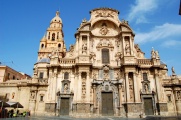

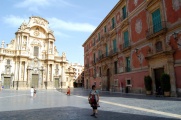
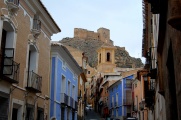
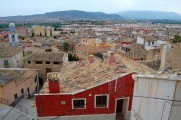
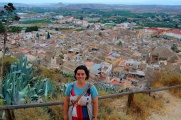
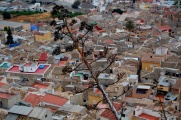
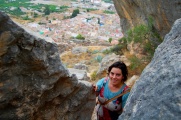

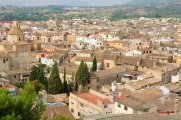
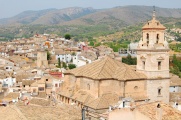

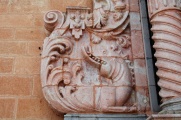
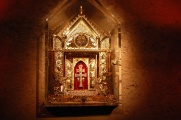
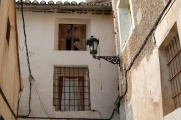
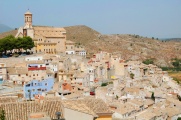

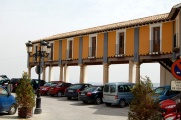
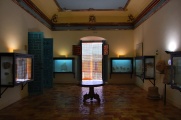
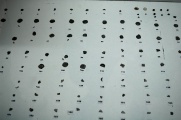
![La casa de las columnas [1] in the eponymous street, with its columns taken from Begastri.](/images/thumb/b/b1/BodaLeoAlex-Cehegin-5.jpg/181px-BodaLeoAlex-Cehegin-5.jpg)
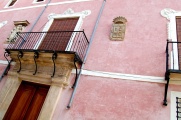


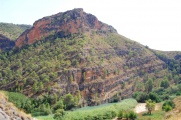



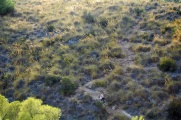
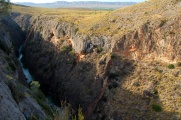


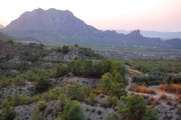

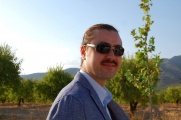
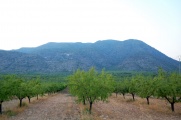
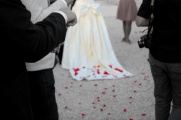

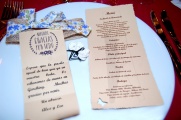
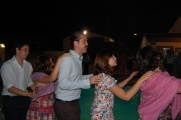
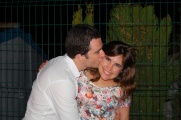

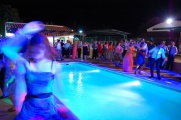
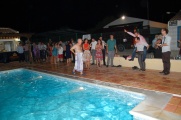
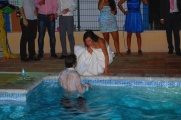
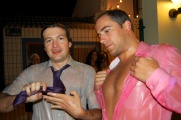
![Meanwhile, others were coping with the inescapable jumping in. Here: Paloma and Emilio [+ Jorge & Hubert].](/images/thumb/0/0d/BodaLeoAlex-boda-14.jpg/181px-BodaLeoAlex-boda-14.jpg)
